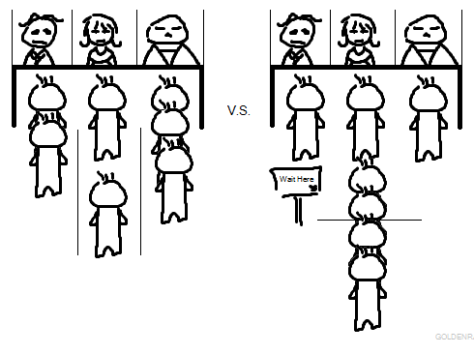Is it an interesting title, isn’t it? 🤔 However, sorry, the topic today is not about a relationship, it’s about a kind of queue. I’m pretty sure each of us, at least one time or a thousand time has been in a queue such as in a bank, in a post office, in an embassy or in a supermarket.
I found out that, a goal is to design a queue that will cut wait time and increase customer satisfaction often the choice between a single line and a multiple line, hence, which is more efficient?
The science of keeping lines moving, known as queue management, is a big deal to big business. Perhaps the most important role players are “line managers,” who monitor the flow of people, direct them to a cash register and, when needed, hold up signs saying how long it will take to check out. (NY Times, Michael Barbaro, Published on 23, June 2007)
How customer think about a single line queue?
Often customers dislike the look of a long line snaking around several turns. For instance, 9 people waiting in one line instead of three people in three different lines can be deceiving for an uneducated customer. He/she may immediately balk by seeing the number of people in a line stretching beyond what they consider the norm. If they relate 3 people wait with four minutes in a traditional system, they may automatically think 9 people wait will take twelve minutes neglecting to take into account that the single line is feeding to three cashiers through a more efficient system.

Any benefit for customers from a single line queue?
People stand in the same line, waiting for a register to become available, there are no “slow” lines, delayed by a coupon-counting customer or languid cashier. It feels long, but conversely gives its users the pleasing feeling of almost constant progress.
The following reasons might be benefits for the customer:
- They can simply jump in line without having to stop, choose, and then fret about which line they are in.
- If a hang-up occurs at one cashier, they do not have to worry that it occurred in the line they chose. Instead, the single line will keep flowing to another point of service.
- An impartial waiting and checkout system that automatically enforces the first come, first served rule, a universal truth in fairness.
This video clip explains the advantage of a single line queue in a mathematic way. You can have a look to understand more how it works.
With all mentions, and only in queueing case, I would say: single is more simple and better!
